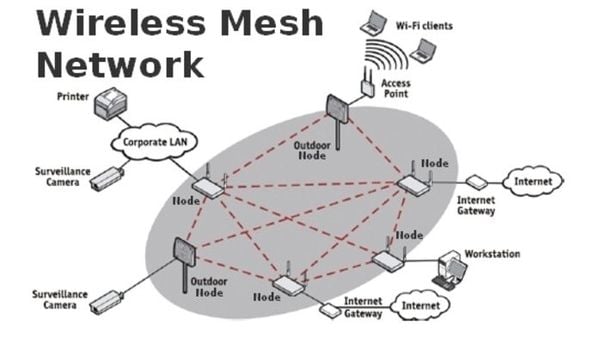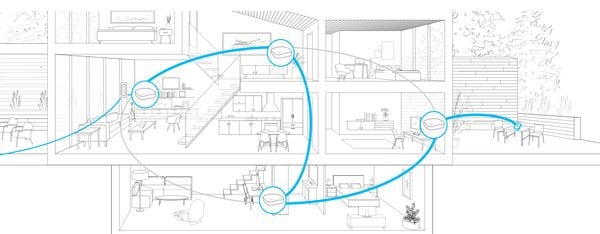
What Are Some New Technologies in the Healthcare IT Sector
December 19, 2018
Various Types of Hosting to Optimize Your Business
January 2, 2019The concept of data decentralization that has been popularized by the Blockchain technology has created a wave of reforms in various industries and fields. Mesh networking is how the concept of decentralization merged with Wi-fi signal and is most probably the future of how we’re going to be accessing the Internet.
Although this type of networking isn’t new by any means, it is a more convenient and cost-effective method of providing your entire living quarters or office with good connectivity without any “blind spots.” But first, we need to look into what mesh networking is.

What is Mesh Networking?
Wireless mesh networks are most probably the best solution to connect devices within a large space to a Wi-fi connection that is equally fast throughout the entire place. You everyday networks normally comprise access points or hotspots. Whereas a mesh network has signal distributed to a large amount of “nods.”
The nodes are the medium which allows the Internet signal to spread throughout the larger area. And yes “node” does sound mysterious and futuristic, but speaking it’s nothing but a connection point.
To be connected to hundreds of users, only one “node” needs to be wired to an Internet modem, and it can be wirelessly connected to any other node in a large space. The connected node will, in turn, share the connection to as many users around as needed. There is no limit to how far the connectivity can be spread. The signal can be limited within a home, a smaller or larger office, or even an entire city, who knows…
Problems of a traditional Wi-Fi Connection
With an extender, an existing connection is re-broadcasted. The extender picks up the signal and then re-transmits it. It does sound good “on paper,” but this wouldn’t be an optimal setup for a small office, for example.
Even the latest and the strongest Wi-Fi routers have to deal with a significant issue in our homes and offices: dead zones. There will be some parts of the building where our connections will suffer if we are too far away from where your router is located. Although this problem can be tackled by using a Wi-Fi bridge or an extender, that does seem to be a bit challenging at times.
How can Mesh Networking helps in Connectivity Problems?
Eliminating Dead Zones throughout your Home/Workspace
Even for a strong Wi-Fi, it is hard for larger houses to find connection everywhere. With a basic router, there will be some dead zones here and there. This problem can be remedied by installing Wi-Fi repeaters or Wi-Fi Extenders, but they are not very easy to install, and they all need power access on their own.
Using mesh networking routers means eliminating the chances of dead zones around your house or small office. While a Wi-Fi router will broadcast signals from one corner of your building, a Mesh Router system will broadcast from numerous points. This means that the whole area will be covered by Internet connections, even when your home/office is more extensive than 3000 square feet or if you have multiple walls in between.
Easier to manage Network
Mesh routers can be easily accessed smartphone. You can use a mobile app to access and control mesh routers even when you’re not in its immediate proximity. While being far away from your router, you can:
- Scan the network speed,
- Create a brand new guest network,
- Cut off Wi-Fi access to a certain network,
- Connect to multiple smart home appliances and devices, and
- Test and compare the different connection points
With a traditional Wi-Fi router, most of these functions are possible, but they have to be done via a desktop/laptop, and you need to be in the router’s range. Besides, you won’t find most of these features in a basic Wi-Fi router, but only in the expensive high-tier ones.
Easy Installation
Wi-Fi extenders are not easy to install, but it might take less than 15 minutes to get your mesh network ready for work. All the individual hubs under a network are automatically programmed to work together, and all that a new user is required to do is to power them up and set up a password. Nothing more!

Privacy
An important property that comes with the decentralization of data is that government agencies will no longer be able to track the users’ and companies’ online activity. This is one of the most important social ramifications of mesh networks.
Drawbacks of Mesh Networking Technology
Although convenient, there also happen to be some drawbacks of using mesh. First of all, this is a relatively expensive technology. It may give you uninterrupted connectivity throughout your home or small office space, but it is expensive compared to a traditional Wi-Fi extender.
Since there will be multiple nodes placed throughout the area you want to be under connection, each node covers a smaller area compared to what a Wi-Fi Extender would have covered.
Mesh technology is supposed to be user-friendly, so it is designed to be reasonably straightforward. Respectively, a mesh router may miss some of the advanced features that can be found in a high-tech router.
There have been a few studies published that suggested that mesh networks are slightly more vulnerable, due to the open medium wireless channel and the fixed topology.
So, should you consider Mesh Networking for your Home or Small Office space?
The answer isn’t straightforward. Mesh networking technology is confidently the future of connectivity, but it comes with a few conditions. This is a choice that can be perfect for certain situations, in other cases, it’s better to stick your good-ole Wi-fi router.
If you are looking for uninterrupted connectivity at every single corner of your home or office, there cannot be a better option than to switch to mesh networking. In a general perspective, this technology focuses isn’t performance, per se, but rather a well-distributed connection that is very easy to manage and set up.
